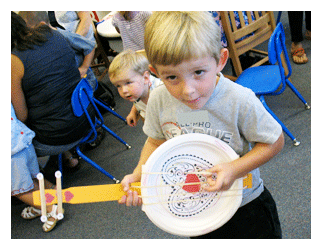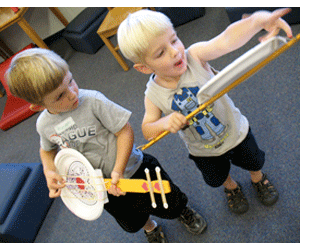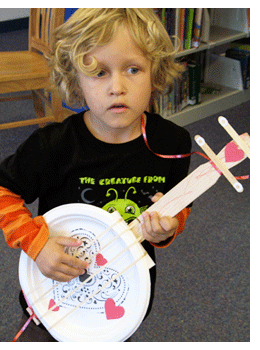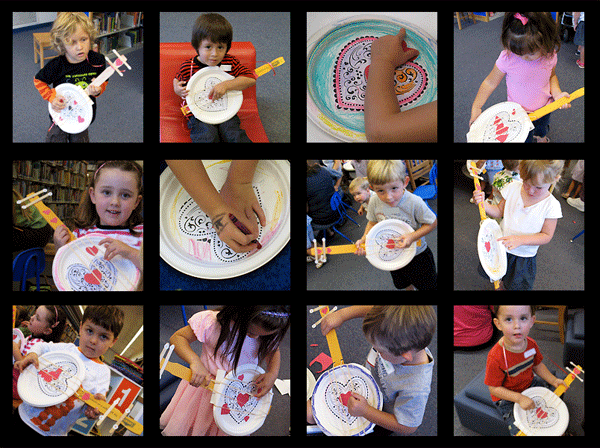 In Haiti, when people gather for storytelling, a person who has a story to tell calls out, “Cric?”
In Haiti, when people gather for storytelling, a person who has a story to tell calls out, “Cric?”
“Crac!” answer the listeners, if they are ready to hear the story.
This week’s story for Page Presents was The Banza, a Haitian tale retold by Diane Wolkstein and illustrated by Marc Brown.
For Mr. Matt’s Minute, Matt introduced Haitian rhythms and drumming styles, which he connected up with the market place rhythm from Africa that we have been learning. Everyone got to play along on rhythm instruments, while I played the market place rhythm on a drum and Matt played cool Afro/Caribbean counter-rhythms on a cowbell. The rhythms were so infectious that the kids started dancing along as they played their shakers or clapped out the beat.
As a prelude to the story, I played “Rhythme de Tambours Bata á Osun” from the CD Islands of the Sun, from Haiti to Trinidad, and got the kids to yell, “Crac!” in response to my “Cric?”.
The story begins with a terrible storm and lots of thunder and lightning. Two small animals take shelter from the storm in a cave and begin talking to each other in the dark. In the morning, they emerge into the light and look at one another. “Be be be-e-e!” bleats Cabree, a small goat. “R-r-rowr-rrr?” says Teegra, a small tiger. “Want to be friends?” asks Cabree. “Now!” Tegree purrs, and they go off through the forest together, playing and exploring. One day Teegra’s family shows up, and Teegra wants to introduce them to Cabree, but Cabree runs into the cave and refuses to come out. Teegra goes home with his family, but he is back the next morning. “Cabree! I have brought you something!” he calls into the cave. “You brought something for me, really?” asks Cabree. “Yes, it’s a banza! It will protect you!” Teegra tells her.
“What’s a banza? asks Cabree, “How can it protect me?” 
“It’s a small banjo. It used to belong to my Uncle,” Teegra replies. “The heart is the strongest thing in the world, Auntie says, and she told me to tell you that if you hold the banza over your heart as you play, one day the heart and the banza will be one!”
“Does it really work?” Cabree wants to know. “Oh, I don’t know, Cabree,” says Teegra, “But I do know that I will never forget you.” And he runs home to his family.
Cabree takes the banza out of the cave to admire it in the daylight. She strokes its strings, and hears a lovely humming sound. She goes off happily, stopping now and then to play the banza. One day, she stops to drink at a pond, but first carefully places her banza where it will not get wet. “Growrrrr!” She looks up, expecting to see Teegra, but instead there are ten fat tigers staring at her hungrily. Oh! how she wants to run away—but she can’t leave her precious banza, Teegra’s gift. She plucks up her courage and slowly moves over to the banza and picks it up. The head tiger taunts her, and Cabree holds the banza over her pounding heart. She accidentally plucks a string, and, before she knows it, she begins singing in a deep, menacing voice:
Ten fat tigers.
Cabree eats tigers raw.
Yesterday Cabree ate ten tigers.
Today Cabree eats ten more.
By the time she has finished, three tigers have disappeared. “Who is Cabree?” the head tiger asks, “And where did you get that song?”
“I am Cabree,” the little goat says in her new deep voice, “and this is my song. I always sing it before dinner.”
The head tiger sends two of the tigers to fetch a drink for Cabree (but privately tells them to not come back).
Cabree looks at the tigers, and sings:
 Five fat tigers.
Five fat tigers.
Cabree eats tigers raw.
Yesterday Cabree ate ten tigers.
Today Cabree eats five more.
Suffice it to say that Cabree triumphs over the tigers, and she sends this message to Teegra: “Today Cabree’s heart and the banza are one!”
After the story, the kids made their own banzas from two heavy-duty paper plates, one long paint stirrer, four strong rubber bands, and two craft sticks. What amazing instruments! My husband, Stuart, improved on a design I found online by cutting notches in the paint stirrers with a jigsaw. This allows the tension in the rubber bands to hold the instrument together, with no need for hot glue and staples.

